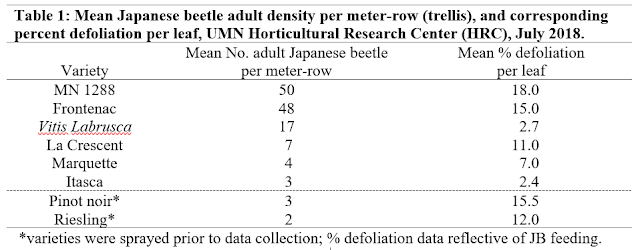 |
| Fig. 1. Japanese beetles aggregating on wine grapes. Photo: Dominique Ebbenga. |
Japanese beetle (Popillia japonica) is an invasive species first detected in Minnesota in 1968. While the insect has been in Minnesota for about 50 years, its population density has been relatively low statewide, with significant numbers building in just the past 3-5 years. In recent years, Japanese beetle (JB) populations have been increasing significantly, primarily in the southeast, south-central regions of the state, but particularly in the 7-country metro.
Fruit and growers have noticed heavy infestations on a variety of crops, including: raspberry, blueberry, apples, plums and wine grapes. The recent “onslaught” of JB on these crops has raised new concerns and questions such as:
What economic or “action” thresholds are available for growers to use in making management decisions? Are there biological control options available for JB? What insecticides or organic options are available?
UMN Entomologists Study Japanese Beetles
New research proposals are being submitted this winter to begin to answer these and other questions, and then help build sustainable integrated pest management (IPM) solutions. In the meantime, however, our research and extension team has been active in collecting preliminary data during 2017-2018, to begin to address some of the IPM questions.In this article, we present some encouraging results regarding varietal differences in resistance to JB that can be useful in helping growers plan ahead with variety selection.
Long summer feeding period
Despite having only one generation per year, our observations for 2018 indicate that the JB adult emergence and survival period is quite extensive, beginning in late June and extending to mid- September (e.g., Rosemount, UMORE Park location, Dakota Co.), suggesting that most crops fruiting during this period will be susceptible. |
| Fig. 2. Adult Japanese beetle on a leaf. Photo: UMN Extension. |
We will provide more updates on JB biology relevant to fruit crops in future articles. JB adults injure plants by feeding between leaf veins, resulting in a “skeletonizing” appearance to the leaves (Fig. 1). Adults cause most of the damage to fruit crop yield and quality, by either feeding on leaf tissue – that could result in longer-term yield impacts – or by direct damage to developing berries, rendering the fruit unmarketable in most cases.
Which varieties do Japanese beetles prefer?
With >300 known host plants, including non-crop hosts such as wild grape, JB can be very opportunistic in colonizing several crops throughout the summer months, and moving from wild grape, or nearby linden trees, to feed on commercial fruit crops. |
| Fig. 3. A grape leaf showing 10% defoliation by Japanese beetles. Photo: Dominique Ebbenga. |
In 2018, we evaluated JB feeding damage on several raspberry and wine grape varieties grown in Minnesota. These studies aimed to quantify mean density of JB adults present (meter-row samples), and the corresponding level of defoliation (% per leaf). See Fig. 3 to visualize what 10% defoliation looks like.
Raspberries: Two popular summer raspberry varieties, ‘Prelude’ and ‘Nova,’ were screened for JB. Results indicated that JB adults showed a preference for the variety Prelude with an average of 22 adults per meter, and average defoliation of 5.39% per leaf (Fig.2). Conversely, Nova only averaged one JB adult, and 0.82% defoliation (Fig. 2). Although not presented here, a popular fall raspberry variety, ‘Heritage’ harbored JB densities that were intermediate between Prelude and Nova.
It must be noted that defoliation may look worse in the field than what it actually is when measured in a lab. The photo below (Fig. 3) may look like about half the leaf is gone, but it is actually only 10% defoliated when analyzed with lab-based leaf area software. This level of defoliation does not necessarily translate to yield loss.
Grapes: Wine grape varieties were also evaluated for JB activity and defoliation, with 8 varieties screened (Table 1). While defoliation did occur, these data do not necessarily translate to yield loss. Still, the results can be very useful in selecting future varieties for new plantings.
Future Japanese Beetle Research
The “new normal” for fruit pest management in Minnesota, is that invasive species are likely here to stay, and that more long-term planning and research will be essential to build more effective, sustainable IPM programs. Further studies will be needed to determine what defoliation levels are necessary to cause economic yield and quality losses.Additional results will be published in future articles to assist growers in understanding the biology of JB, and how this information, along with additional pest management tactics can be useful for building sustainable IPM programs. Please refer to the FruitEdge web page (www.fruitedge.umn.edu) for new research-based updates for managing JB and other insect pests of MN fruit crops.
Authors: Dominique
Ebbenga, Eric Burkness, Matt Clark & Bill Hutchison
Dept. of
Entomology, Dept. of Horticultural Science, & MN Extension IPM Program,
University of Minnesota, St. Paul campus


Bill-you can include Boyne Raspberry in the low loss category. I didn't see a ton of defoliation, nor was there any loss in yield. In fact, I had more JB defoliation overall this year, however the largest Raspberry yields yet in 3 yrs of production. Canes, leaves, and fruit fared very well. Way more damage to Sommerset and Trollhaugen table grapes in a completely different area of our parcel. Will be netting those next season for JB.
ReplyDelete